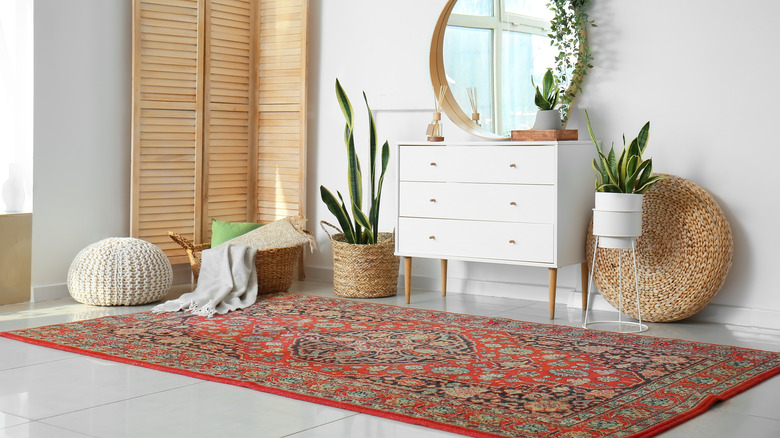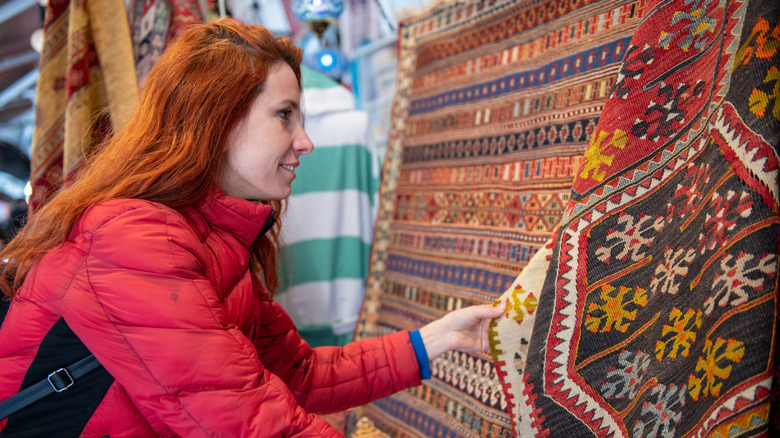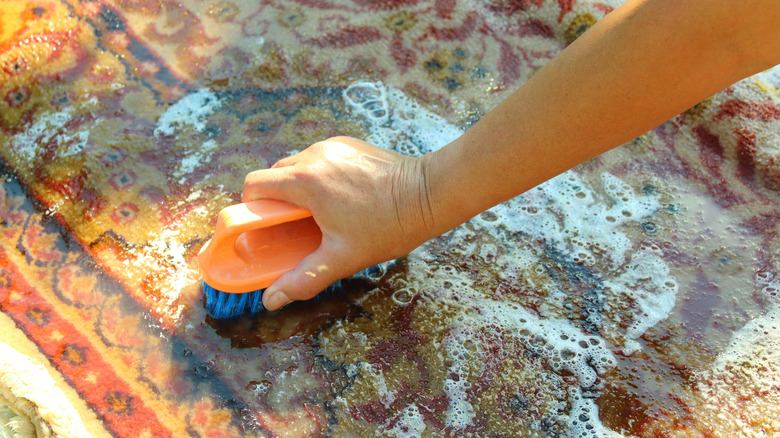The Living Room Essential That You Should Always Buy Vintage, According To Designers
Vintage home décor and furnishings remain popular for their distinctive style, sustainability, and craftsmanship. This is especially true for vintage rugs, which offer a rich history, unique designs, gorgeous detail, and superior quality craftsmanship — and the living room essential you should always buy vintage is Persian rugs, renowned for their artistry and connection to history.
Younger designers and homeowners are gravitating to Persian rugs for more than the aesthetic. Vintage Persian rugs offer a blend of old and new. These rugs represent unique stories and showcase centuries-old craftsmanship that stand in contrast to the cookie-cutter, mass-produced rugs and the environmental impact of fast furniture. Sara Swabb of Storie Collective shared that "Vintage Persian rugs ground a space both literally and emotionally." (via Homes and Gardens)
Vintage rugs make any space feel grounded and rooted in history and tradition. They can be found in colors ranging from bold to a faded patina, with more muted shades. A vintage Persian rug can be paired with traditional, minimalist, and modern design elements. Although you can find machine-made approximations, vintage rugs are hand-knotted by skilled artisans, using techniques that have been honed over centuries.
Where to shop for vintage Persian rugs
When you start your search for vintage Persian rugs, you can find a great selection from specialty vintage rug retailers in your area or online. There are websites that focus on authentic antique and vintage rugs with curated collections. However, these can be the most expensive option, with prices ranging from several hundred to several thousand dollars, depending on the age, pattern, and size of the rug.
An online antique rug retailer or vintage rug dealer isn't the only option for buying authentic Persian rugs. A vintage Persian rug might be your best find at the next estate sale you visit. You could also get lucky and spot a great find at a local antique store, thrift shop, or yard sale. People often use online secondhand marketplaces like eBay or Facebook Marketplace to sell vintage rugs, as well.
Assessing the quality and authenticity of a rug is more difficult when buying from a private seller or an online marketplace, but there are still things you can look for. Vintage Persian rugs are made with high-quality natural materials, such as wool, silk, and cotton. Turn the rug over and look for individual knots that mirror the pattern on the front and a soft cotton or wool backing, rather than plastic. Slight variations in knotting are common in handmade rugs. Inspect the fringe, which should be an integral part of the rug. Fringe that is glued or sewn on separately is a sign of a machine-made rug.
What to consider when styling vintage Persian rugs
When shopping for a vintage rug, be open to bolder colors and detailed patterns. Keeping things too neutral is one of the common mistakes people make when choosing a new rug. Regardless of color or pattern, these rugs will definitely prove to be a focal point in any room or entryway. In a neutral-colored space, the rug can add the pop of color needed to texture and characterize the aesthetic.
For instance, in the living room, a rug can anchor the space, especially in an open-floor plan home. You can arrange your furniture around it to define the space and create a cohesive look for the room. In this case, make sure the rug is large enough to fill the space created by the furniture around. Vintage rugs can be used in any room of the home; just make sure the size is right to fit the space.
Your new vintage rug may need cleaning. You can have an area rug professionally cleaned for around $2 to $8 per square foot, with antique and Persian rugs landing on the pricier side. You can also use this tip to give your rugs a deeper clean at home: Start by vacuuming both sides of the rug slowly to remove as much dirt and debris as possible, using care to avoid damaging the fringe. Use a rug shampoo safe for Persian rugs, or mix 1 tablespoon of liquid dish soap in ½ cup of warm water. Dampen the rug, use a soft brush to gently scrub with the cleaning agent, and rinse with water. Rinse thoroughly to avoid lingering soap that can attract dirt, and always spot-check to ensure the dyes don't bleed.


